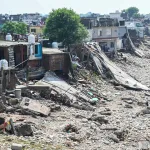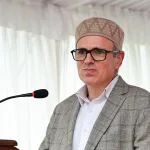Srinagar, Dec 31: Kashmir, a region with a unique cancer profile, has seen a rise in cancer cases, according to data from Sher-i-Kashmir Institute of Medical Sciences, Soura, GMC Srinagar, and other medical colleges with public health experts picking holes in healthcare from inadequate infrastructure to staff shortage.
According to data from the State Cancer Institute (SCI) at SKIMS, over 28,457 cancer cases have been registered from 2019 to 2024 (in six years). The SCI, a major tertiary care facility, offers comprehensive cancer treatment to patients across Jammu, Kashmir, and Ladakh.
As per official data, SKIMS recorded 4,337 cases in 2019, 3,814 cases in 2020, 4,727 cases in 2021, 5,271 cases in 2022, 5,108 cases in 2023 and over 5,200 cases in 2024.
Similarly, this year, Government Medical College Srinagar’s Medial Oncology Department has logged 1300 cases of different types of cancers, a trend that has continued over the years.
Dr. Javid Muzammil, HoD Medical Oncology, GMC Srinagar, said this year alone, 1,300 new patients were registered and 7,000 patients have received chemotherapy and other supportive services. “Each year, we register 1,200 to 1,300 new cancer patients,” he said.
He stated that the top five most prevalent cancers in Kashmir are gastrointestinal (GI) cancer, lung cancer, breast cancer, colon cancer, and ovarian cancer.
“We consume more salty and fried foods, which are major risk factors for GI cancer in Kashmir. Rampant smoking, both in men and women, is the leading cause of lung cancer, with 30 percent of cases caused by second-hand smoke,” he said.
Regarding breast cancer, Dr. Javid said that urbanization, obesity, hypertension, infertility, sedentary lifestyle, late marriages, and delayed deliveries are major global risk factors.
As per the doctor, Kashmir is witnessing an uneven trend of colon cancer as it is now more commonly seen in the young population, whereas it traditionally affects those over 45.
“Here, colon cancer occurs about a decade and a half earlier than in the rest of the world. When it appears early, it is often very aggressive, and survival rates are low. Most of these patients present to us at stage four,” he said.
The doctor said that he recently treated two children, both diagnosed with colon cancer—one 16-year-old male and one 11-year-old female adding both were in stage four.
He explained that most cancers are lifestyle diseases, and if people change their lifestyle, these diseases can be controlled to a large extent.
“Regular screenings and health check-ups are crucial for early disease detection. Screening helps identify asymptomatic patients, enabling timely curative surgery,” the doctor said.
The senior doctor said that 50 percent of the patients who come to the hospital are in stage four, and many are unaware that they have cancer.
“There is a need of a taskforce and healthcare workers in rural hospitals should be trained. There should be good communication between rural and tertiary care hospitals,” he said.
A senior oncologist in the Department of Medical Oncology SKIMS, it is a good sign that people are coming to hospitals for treatment ending the stigma associated with cancer.
“There is an increasing trend in the valley in cancers like stomach, lung, and breast however there has been a slight decrease trend of esophageal cancer,” he said.
The oncologist highlighted advances in diagnosis and treatment, leading to higher survival rates, with many patients living normal lives and some surviving over five years.
Notably, the medical oncology department of GMC Srinagar and the newly established GMCs in Baramulla and Anantnag continue to face manpower and infrastructure issues.
However, there is still a lack of radiotherapy facilities in rural hospitals saying if developed it could help to minimize the huge burden on tertiary care hospitals in Srinagar.
Dr Zahoor Ahmad Paul, HoD and Associate Professor, Radiotherapy GMC Baramulla said the cancer treatment facilities were started there in 2021 and since then the cases have risen.
The number of registrations has steadily increased over the years, with 52 in 2021, 76 in 2022, 89 in 2023, and more than 90 in 2024, averaging 4 to 5 patients daily.
Similarly, Paul said patients who visited GMC Baramulla for treatment-related complications have increased, with 234 in 2021, 482 in 2022, 459 in 2023, and 700 in 2024.
The new medical college provides OPD, day care ward and palliative services to cancer patients. It plans to have radiotherapy equipment as part of its infrastructure upgrade.
“This facility has come has a hope for the patients of entire north Kashmir and we are working hard in this direction,” he said.
On the other side, people from different areas of south Kashmir have been voicing their concern for the establishment of a Regional Cancer Center (RCC) in GMC Anantnag as cancer cases have seen an upward trend in the region.
Official figures reveal that in the last few years, 1600 cancer patients have been registered at GMC Anantnag and the numbers are quite high as most of the patients travel to Srinagar.
“About 60-65 percent of patients require radiotherapy treatment at some phase of their treatment for which they are referred to Srinagar,” said a senior doctor from Anantnag.
The GMC Anantnag caters to over 30 lakh people from South Kashmir including Shopian, Pulwama, Kulgam, Anantnag, and adjoining areas of Ramban, Banihal, Doda, and Kishtwar.
However, officials said the demand for RCC in south Kashmir has been raised with the relevant authorities in the Government of India but they haven’t got any reply.
Kashmir sees rising trends in cancer cases
• Healthcare suffers from inadequate infra, staff shortage: Experts • Gastrointestinal (GI), lung, breast, colon, and ovary cancers more prevalent in valley • This year, SKIMS reports 5,200 cancer cases, GMC Srinagar 1300 cases

Leave a Comment Leave a Comment






